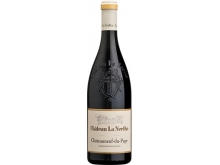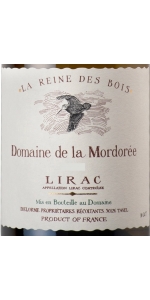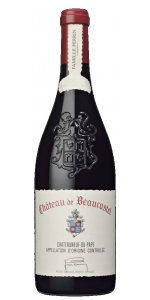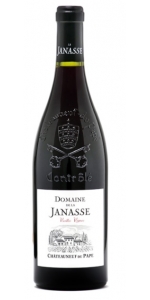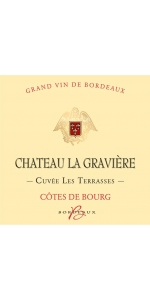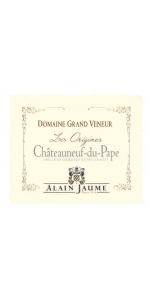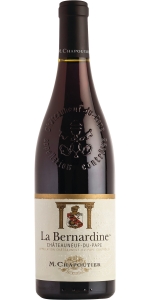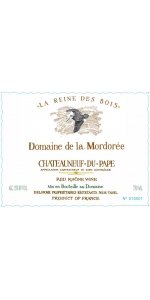Chateau La Nerthe Chateauneuf-du-Pape Rouge 2021
6 bottles with free shipping for: $480.00
12 bottles with free shipping for: $900.00
| BUY MORE! SAVE MORE! | ||||||||||||||||||||
|
| Country: | France |
| Regions: | Rhone Chateauneuf du Pape |
| Winery: | La Nerthe |
| Grape Type: | Grenache |
| Organic: | Yes |
| Vintage: | 2021 |
| Bottle Size: | 750 ml |
Chateau La Nerthe Chateauneuf-du-Pape Rouge is made from Grenache 39%, Mourvédre 33%, Syrah 25%, Cinsault 2%, Others 1%.
Château La Nerthe is one of the oldest estates in Châteauneuf-du-Pape and dates from 1560. Château La Nerthe has 227 acres of vineyards that surround the château and top the renowned La Crau plateau. The terroir is typical of the region. Vineyards run along a slope and grow in sandy-clay soils. The ground is covered by a layer of ‘galets’ – large, round, well-worn stones that were carried down from the Alps by glaciers during the last ice age. All the 13 permitted primary varietals are planted here. Grenache dominates 62% of the vineyards and the average vine age is over 40 years old. The grapes are hand harvested and sorted on tables. The grapes are then put into vats for almost 4 weeks with regular pump overs and punch downs. The must is tasted every day during fermentation to ensure the best extraction of the berry compounds. At the end, the wines are racked into oak vats for malolactic fermentation. The cuvée is then aged in large French oak casks and barrels for 12 months before blending. Bottling takes place 6 months later.
The dark, deep, inky color of the wine shows immediately, stemming from the concentration of the vintage. Nose of blackcurrants, black tea and dried flowers stands out. The mouth is rich, fruity and velvety with an incredibly layered tannic structure. The wine is balanced and pure with strong intense and incredibly long aging potential.
- One of the oldest estates in Châteauneuf-du-Pape - dates from 1560
- Estate grown, hand harvested, estate bottled
- Average vine age is 40+ years
- Certified AB Organic
Review:
A focused expression, this wine delivers pure red and black fruits unfolding against a delicate rose-petal backdrop. Silky yet chewy tannins gradually reveal layers of red cherry, pomegranate, spice, violets, and a hint of clove. Its elegance is underscored by fine tannins, suggesting a wine that, while quiet now, holds the promise of revealing its full beauty with time in the bottle. Cellaring through 2028+ before revisiting should prove to be rewarding.
-Wine Enthusiast 93 Points
Wine grapes have been grown at the estate since the 1500s, making it one of the oldest estates in Châteauneuf-du-Pape.
- Exceptional, sloped terroir with soils of sandy-clay and a layer of large, round, well-worn galet stones
- All the terroirs of Châteauneuf-du-Pape in a single estate
- All 13 of the permitted primary varietals are planted
- Average vine age over 40 years old
- Certified AB Organic since 1998
- A veteran, acclaimed winemaking team and a rich, unique history
Château La Nerthe is in contention for being one of the oldest estates in Châteauneuf-du-Pape. The estate was first purchased by the Tulle de Villefranche family in 1560. The historic Château was built in 1736. Château La Nerthe deserves credit for being one of the first estates to bottle their own wine. This took place to some extent starting in 1784. Château La Nerthe is one of the first, if not the first estate in Châteauneuf-du-Pape to export their wine outside of France. Another first that belongs to the estate is that Château La Nerthe began the practice of destemming 100% of their vines in the 1800’s. By this point in time, Château La Nerthe was the most expensive wine from the Southern Rhône.
In 1870, the Tulle de Villefranche family sold the property to the Joseph Ducos family. The sale took place in part, because of the devastation caused to the vineyards by Phylloxera. The Ducos family made their mark on Chateau la Nerthe’s history by replanting the vineyard on grafted phylloxera rootstock and by planting new, local grape varieties; 10 of the 13 permitted varietals were planted. The Ducos family maintained ownership of the property until 1941 when Château La Nerthe was bought at an auction by the Leclerc and Motte families.
By 1985, Château La Nerthe had become dilapidated and was put up for sale by the Dereumaux family and purchased by the Richard family in partnership with David and Foillard negociants. Their goal for the estate was to revive the original values of excellence and innovation. A complete renovation of the estate took place and much of the vineyards were replanted. In 1991, Château La Nerthe was able to expand their holdings with the purchase of 54 acres of vines, which helped to create one of the largest estates in the Southern Rhône with 230 acres. In 1998, the vineyard is certified organic. Rémi Jean joined the Chateau la Nerthe team in late 2019 and has been placed in charge of the estate and its winemaking. Rémi Jean has had a long partnership with the Richard Family Wineries, previously worked as General Manager for their Bordeaux properties, Château de Corcelles and Château des Tours.
Mordoree Lirac Blanc Reine des Bois is made from Grapes : Grenache 35 % Clairette 25 % Viognier 10 % Roussanne 15 % Marsanne 10 % Picpoul 5%>
Color : green gold
Aromas : white fruits, peach, apricot, pear, violet.
Palate : rounded, long finish, highly flavoured.
Ageing Potential : 4-5 years.
Surface : 4 Ha. Yield : 35 Hl./Ha. Vineyard age : 30 years Terroir : Clay / chalk with pebble stones. Harvest : by hand Vinification : skin maceration and direct pressing with temperature control. Fermentation : oak barrel fermentation for 25% of the total volume
Pairs well with appetizers, fish, seafood.
Review:
"Iconic grapes of 35% Grenache, 25% Clairette, 10% Viognier, 15% Roussanne, 10% Marsanne, and 5% Picpoul from 40-year-old vines make up this organic Southern Rhône white. A floral bouquet of white tea and jasmine make their designs on a defined slate mouthfeel. Lime pops with a tart center, along with notes of peach and gingerbread on a keen, edgy finish."
- The Somm Journal (Feb/March 2022), 94 pts
Chateau de Beaucastel Chateauneuf-du-Pape Rouge is made from 30% each Grenache and Mourvèdre, with 10% each Counoise and Syrah, plus 20% other permitted varieties, including a healthy proportion of white grapes.
The story :
Château de Beaucastel has long been considered one of the great wines of France. It is unanimously renowned for its balance, elegance and ageing potential. Beaucastel has an extraordinary terroir at the Northern end of the appellation with heavy exposure to the Mistral. All 13 varieties of the appellation have been organically grown here since the sixties.
Location :
Châteauneuf du Pape, between Orange and Avignon, Château de Beaucastel red is a 70-hectare vineyard.
Terroir :
Château de Beaucastel is 110 hectares, with one single plot at the north of the appellation. The terroir is archetypal of the best terroirs in Châteauneuf: rolled pebbles on the surface, sand, clay and limestone deeper down. The vines are old and have been organically grown for 50 years, which has allowed the roots to grow exceptionally deep.
Beaucastel grows all thirteen grape varieties authorised by the appellation.
Ageing :
Each variety is harvested manually and separately. Vinification is completed in truncated oak barrels for the reductive grapes (Mourvèdre and Syrah) and in traditional tiled cement tanks for the oxidative grapes (such as Grenache). After the malolactic fermentations, the family blends the different varieties and then the wine ages in oak Foudres for a year before bottling.
Review:
deep, quite herbal expression, with liquorice and crushed blueberries to the cassis fruit. Full-bodied, powerfully fruited, dense and deep. Really mouthcoating, intense fruit. The tannins are ripe, fine and plentiful, all saturated in blackberry juice on a long finish. Certainly one of the more successful Châteauneufs this year. Will age well. A Mourvèdre-led expression of Beaucastel - it contains more than usual, at least 35% and probably more. Grenache and Cinsault fermented in cement, Syrah and Mourvèdre fermented in foudre. (MW) (9/2022)
-Decanter 96 Points
Domaine de la Janasse Chateauneuf-du-Pape Cuvee Vieilles Vignes is made from 65% Grenache, 20% Mourvèdre, 10% Syrah, 5% divers.
In contrast to Chaupin, which is made from old-vine Grenache on sandy soils, the cuvée Vieilles Vignes is from old vines of Grenache, Mourvedre, Syrah along with smaller percentages of other permitted varieties that are grown in these old vineyards. The wine is sourced from 4 terroirs: pebbly clay, sand, gravelly red clay and sandy limestone. Vieilles Vignes is always the most powerful and concentrated Châteauneuf-du-Pape cuvée made at Domaine de la Janasse.
Review:
The advantages of old vines are perhaps most evident in the more difficult vintages (whether hot and dry or cool and rainy). The 2021 Chateauneuf du Pape Vieilles Vignes is a strong effort, delivering supple, velvety waves of ripe black cherries and black raspberries. Medium to full-bodied, it's rich and concentrated without seeming at all heavy or unbalanced, finishing long and juicy. It's approximately 75% Grenache, 15% Mourvèdre, 5% Syrah and 5% other varieties, keeping in mind that up to 15% of the old Grenache vines are actually Clairette Rose.
-Wine Advocate 96 Points
Graviere La Rouge Cuvee les Terrasses is made of 70% Merlot and 30% Cabernet Sauvignon
Deep red color with a narrow purple rim. Attractive aromas of ripe, juicy cherry and blackberry over spice, integrated toasted aromas. The palate is balanced and full-bodied with supple tannins, displaying rich cherry flavors combined with gentle toasting characters and a touch of spice. The finish is lasting with a bitter almond aftertaste.
Average age of the vines is 25 years.
Manual harvest from September 21th to October 7th 2015.
Upon arrival at the winery, only the best grapes were selected using a sorting table.
Skin contact maceration during 2 weeks in temperature controlled vats.
75% of the final wine was aged in stainless steel tanks with French oak staves and blended with 25% of wine aged in barrels.
Serve with red, white meats, poultry and fine cheeses.
Grand Veneur Chateauneuf-du-Pape Rouge Les Origines is made from 50% Grenache, 30% Mourvedre and 20% Syrah
Matured in vats (grenache) and in oak casks (syrah and mourvèdre).
Deep and brilliant, purple-red colour. An exciting nose with aromas of black fruit (blackcurrant, cherry) spices and vanilla. This great aromatic complexity is found on the palate : the spices and ripe fruit appear with an elegant woodiness and harmonious tannins. The finish has good aromatic length and introduces a touch of liquorice and pepper.
A terrific Châteauneuf du Pape with great concentration and finesse.
Best between 2 and 20 years. Best to decant if young (less than 5 years old).
Soil type Extreme north of Châteauneuf du Pape. This plateau is made with a high quantity of red clay mixed with rocks. This area is considerated to be one of the best to produce rich and powerful red wines. By definition, LES ORIGINES will always deliver a great complexity and ageing potential. Winemaking & ageing Harvest is sorted by hand, destemmed and crushed. Fermentation temperature is controlled at 30°C. Vatting period of 18 to 20 days. Matured in vats (grenache) and in oak casks (syrah and mourvèdre).
Review:
"The full dry tannins shape the personality of this bold and crisp Chateauneuf. Aromas of dry earth, savory and black pepper. Seriously structured finish where the tannins need some time to resolve. A cuvee of 50% grenache, 30% mourvedre and 20% syrah. From organically grown grapes. Drinkable now, but best from 2025."
- James Suckling (April 2023), 92 pts
Maison Chapoutier Chateauneuf-du-Pape La Bernardine 2021 is made from 75% Grenache, 15% Syrah, 10% Mourvèdre.
Intense crimson-red in color with a complex but subtle nose of blackcurrant and plum followed by roasted coffee, cinnamon, and cherry. On the palate, it opens into spice, licorice and fruity notes.
Review:
A textural, refined and velvety Chateauneuf-du-Pape with aromas of forest berries, wet stones, roasted meat, wild herbs and some bark. It’s medium- to full-bodied with fine, firm tannins. There is a refined texture here, silky at the center, with a delicate core of dark cherries challenged by an intense array of spices that provide verve and energy.
-James Suckling 93 Points
Mordoree Chateauneuf-du-Pape La Reine des Bois is made from Grenache 75 %, Mourvèdre 10%, Syrah 10 % , Counoise 3% & Vaccarese 2%.
This premium cuvee - whose name means "Queen of the Woods" - is from 65-year-old vines, planted on Villafranchian-era terrasses. Yield is 30 hl/ha.
Deep ruby red; opaque. Aromas of red fruits change to wooden touches of leather, black truffles and coffee. Fat, concentrated and full flavored with a very long liquoriced and fruity finish.
Pairs with red meats, sauce dishes, game animals (woodcock, wild boar) and semi mature cheeses.
Review:
"The 2019 Châteauneuf Du Pape Cuvée De La Reine des Bois is a deeper, more masculine wine with gorgeous cassis and blackberry fruits as well as graphite, licorice, crushed stone, violets, and lavender nuances. Rich, full-bodied, and incredibly concentrated, it has a brilliant sense of freshness and purity as well as length on the finish. It's going to require 4-5 years of bottle age, but this straight-up thrilling Châteauneuf du Pape will have 20-25 years of prime drinking."
- Jeb Dunnuck (November 2021), 98+ pts
- back
Pulled from a Gentleman's cellar, all wines from this cellar have been purchased by the owner either from the importer or direct from winery. They stayed in his cellar until being moved to the Timeless Wines warehouse.
Review:
Lastly, and a wine that will be a candidate for perfection in 4-5 years, the 2019 Châteauneuf Du Pape Centenaire reveals a deep ruby/purple hue as well as extraordinary notes of black cherries, licorice, iron, nori, and peppery garrigue. As with the base 2019, the estate did an incredible job with the tannins, and this wine is flawlessly balanced, with ultra-fine tannins, no hard edges, and the sheer class to evolve for 25+ years. This is a perfect example of power with no sensation of weight or heaviness. The blend in 2019 is 84% Grenache, 10% Mourvèdre, and 6% Syrah, and it wasn’t destemmed and was brought up mostly in concrete tanks, with just 6% in very old barrels.
-Jeb Dunnuck 98 Points

